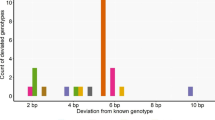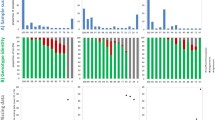Abstract
Wildlife management and conservation take advantage of the possibility to study free-living populations by collecting and analysing noninvasive samples. Nevertheless, the commonly adopted approaches, aimed at preventing results being affected by genotyping errors, considerably limit the applicability of noninvasive genotyping. An empirical approach is presented for achieving a reliable data set of wolf (Canis lupus) genotypes from multiple sources of DNA collected in a monitored population. This method relies on the relationship between sample quality and amplification outcome, which is ultimately related to the occurrence of typing errors (allelic dropout, false alleles). After DNA extraction, templates are amplified once at each locus and a conservative rating system (Q-score) is adopted to define the quality of single-locus amplifications. A significant relationship was found between quality scores and error rate (ER) (r 2=0.982). Thus it was possible to predict the chance a genotype has of being affected by errors on the basis of its Q-score. Genotypes not reaching a satisfactory confidence level can either be replicated to become reliable or excluded from the data set. Accordingly, in the present case study, 48–73% of all single-locus and 51–53% of all multilocus (ML) genotypes reached a sufficient (99 and 95%, respectively) reliability level after a single amplification per locus. Despite the possible decrease in overall yield, this method could provide a good compromise between accuracy in genotyping and effectiveness in screening large data sets for long-term or large-scale population surveys. However, to achieve complete and reliable data sets, replicated amplifications are necessary for those samples and loci providing poor results.
Similar content being viewed by others
References
Beecham GW (2004) DNAMIX v.3 Available at: http://www.statgen.ncsu.edu/∼ ∼gwbeecha/
Broquet T, Petit E (2004) Quantifying genotyping errors in noninvasive population genetics. Mol. Ecol., 13, 3601–3608.
Constable JL, Ashley MV, Goodall J, Pusey AE (2001) Noninvasive paternity assignment in Gombe chimpanzees. Mol. Ecol., 10, 1279–1300.
Creel S, Spong G, Sands JL, Rotella J, Zeigle J, Joe L, Murphy KM, Smith D (2003) Population size estimation in Yellowstone wolves with error-prone noninvasive microsatellite genotypes. Mol. Ecol., 12, 2003–2009.
Francisco LV, Langston AA, Mellersh CS, Neal CL, Ostrander EA (1996) A class of highly polymorphic tetranucleotide repeats for canine genetic mapping. Mamm. Genome, 7, 359–372.
Gagneux P, Boesch C, Woodruff DS (1997) Microsatellite scoring errors associated with noninvasive genotyping based on nuclear DNA amplified from shed hair. Mol. Ecol., 6, 861–868.
Golenberg EM, Bickel A, Weihs P (1996) Effect of highly fragmented DNA on PCR. Nucleic Acids Res., 24, 5026–5033.
Goossens B, Waits LP, Taberlet P (1998) Plucked hair samples as a source of DNA: Reliability of dinucleotide microsatellite genotyping. Mol. Ecol., 7, 1237–1241.
Hedmark E, Flagstad Ø, Segerström P, Persson J, Landa A, Ellegren H (2004) DNA-Based individual and sex identification from wolverine (Gulo gulo) faeces and urine. Conserv. Genet., 5, 405–410.
Higuchi R, Von Beroldingen CH, Sensabaugh GH, Erlich HA (1988) DNA typing from single hairs. Nature, 332, 543–546.
Kohn MH, Wayne RK (1997) Facts from feces revisited. Trends Ecol. Evolut., 12, 223–227.
Lucchini V, Fabbri E, Marucco F, Ricci S, Boitani L, Randi E (2002) Noninvasive molecular tracking of colonizing wolf (Canis lupus) packs in the western Italian Alps. Mol. Ecol., 11, 857–868.
Maudet C, Luikart G, Dubray D, Von Hardenberg A, Taberlet P (2004) Low genotyping error rates in wild ungulate faeces sampled in winter. Mol. Ecol. Notes, 4, 772–775.
Miller CR, Joyce P, Waits LP (2002) Assessing allelic dropout and genotype reliability using maximum likelihood. Genetics, 160, 357–366.
Morin PA, Woodruff DS (1996) Noninvasive genotyping for vertebrate conservation. In: Molecular Genetic Approaches in Conservation (eds. Smith TB, Wayne RK), pp. 298–313. Oxford University Press, New York.
Morin PA, Chambers KE, Boesch C, Vigilant L (2001) Quantitative polymerase chain reaction analysis of DNA from noninvasive samples for accurate microsatellite genotyping of wild chimpanzees (Pan troglodytes verus). Mol. Ecol., 10, 1835–1844.
Murphy MA, Waits LP, Kendall KC (2003) The influence of diet on faecal DNA amplification and sex identification in brown bears (Ursus arctos). Mol. Ecol., 12, 2261–2265.
Navidi W, Arnheim N, Waterman MS (1992) A multiple-tubes approach for accurate genotyping of very small DNA samples by using PCR: Statistical considerations. Am. J. Hum. Genet., 50, 347–359.
Ostrander EA, Sprague GF, Rine J (1993) Identification and characterization of dinucleotide repeat (CA)n markers for genetic mapping in dog. Genomics, 16, 207–213.
Ostrander EA, Mapa FA, Yee M, Rine J (1995) One hundred and one new simple sequence repeat-based markers for the canine genome. Mamm. Genome, 6, 192–195.
Paetkau D (2003) An empirical exploration of data quality in DNA-based population inventories. Mol. Ecol., 12, 1375–1387.
Parsons KM (2001) Reliable microsatellite genotyping of dolphin DNA from faeces. Mol. Ecol. Notes, 1, 341–344.
Piggott MP, Taylor AC (2003) Remote collection of animal DNA and its applications in conservation management and understanding the population biology of rare and cryptic species. Wildl. Res., 30, 1–13.
Scandura M (2005) Individual sexing and genotyping from blood spots on the snow: A reliable source of DNA for noninvasive genetic surveys. Conserv. Genet., DOI 10.1007/s10592-005-9041-5.
Sloane MA, Sunnucks P, Alpers D, Beheregaray LB, Taylor AC (2000) Highly reliable genetic identification of individual northern hairy-nosed wombats from single remotely collected hairs: A feasible censusing method. Mol. Ecol., 9, 1233–1240.
Sokal RR, Rohlf FJ (1995) Biometry: The principles and practice of statistics in biological research, 3rd edn. WH Freeman and Company, New York.
Taberlet P, Griffin S, Goossens B, Questiau S, Manceau V, Escaravage N, Waits LP, Bouvet J (1996) Reliable genotyping of samples with very low DNA quantities using PCR. Nucleic Acids Res., 24, 3189–3194.
Taberlet P, Camarra J-J, Griffin S, Uhrès E, Hanotte O, Waits LP, Dubois-Paganon C., Burke T, Bouvet J (1997) Noninvasive genetic trasking of the endangered Pyrenean brown bear population. Mol. Ecol., 6, 869–876.
Taberlet P, Luikart G (1999) Non-invasive genetic sampling and individual identification. Biol. J. Linn. Soc., 68, 41–55.
Taberlet P, Waits LP, Luikart G (1999) Noninvasive genetic sampling: look before you leap. Trends Ecol. Evolut., 14, 323–327.
Triant DA, Pace RM, Stine M (2004) Abundance, genetic diversity and conservation of Louisiana black bears (Ursus americanus luteolus) as detected through noninvasive sampling. Conserv. Genet., 5, 647–659.
Valière N. (2002) GIMLET: A computer program for analysing genetic individual identification data. Mol. Ecol., 2, 377–379. Available at: http://www.pbil.univ-lyon1.fr/software/Gimlet/gimlet.htm
Van Oosterhout C, Hutchinson WF, Wills DPM, Shipley P (2004) MICRO-CHECKER: A software for identifying and correcting genotyping errors in microsatellite data. Mol. Ecol. Notes, 4, 535–538. Available at: http://www.microchecker.hull.ac.uk/index.jsp
Walsh PS, Metzger DA, Higuchi R (1991) Chelex-100 as a medium for simple extraction of DNA for PCR-based typing from forensic material. Biotechniques, 10, 506–513.
Woods JG, Paetkau D, Lewis D, McLellan BN, Proctor M, Strobeck C (1999) Genetic tagging of free-ranging black and brown bears. Wildl. Soc. Bull., 27, 616–627.
Acknowledgements
We wish to thank all the people who participated in the wolf monitoring program in the province of Arezzo, among whom we are particularly grateful to Elisa Avanzinelli, Alessia Viviani, Andrea Gazzola, Paolo Lamberti and Luca Mattioli. We also thank Francesca Di Benedetto for her contribution to lab activities and James Burge for linguistic revision. Suggestions by the associate editor and two anonymous reviewers allowed to improve the final draft of the manuscript. Financial support was provided by the Provincial Administration of Arezzo and by the Italian Ministry of University and Research (COFIN 2003, # prot. 2003053710).
Author information
Authors and Affiliations
Corresponding author
Additional information
An erratum to this article can be found at http://dx.doi.org/10.1007/s10592-006-9216-8
Rights and permissions
About this article
Cite this article
Scandura, M., Capitani, C., Iacolina, L. et al. An empirical approach for reliable microsatellite genotyping of wolf DNA from multiple noninvasive sources. Conserv Genet 7, 813–823 (2006). https://doi.org/10.1007/s10592-005-9106-5
Received:
Accepted:
Published:
Issue Date:
DOI: https://doi.org/10.1007/s10592-005-9106-5




